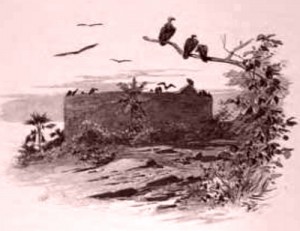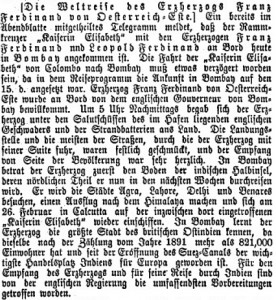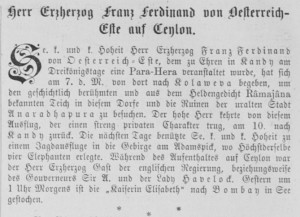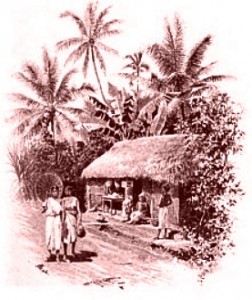Early in the morning we drove in gala coaches of the governors, escorted by a part of the guard, to the docks to inspect the Lloyd ship „Elektra“ which arrived two days ago. The docks built and owned by trading companies are impressive structures both in their extent as well as their requirements for the installation of the necessary equipment for the transport of goods. It is a testament to entrepreneurship which makes one feel meek if one compares it to home. Beside the docks stand warehouses through which the stream of arriving and departing goods flows: As the blood flows without interruption in the numerous branches of the veins in a human organism, bringing blood to the heart and moving it away again, so here barrels and bales roll without interruption on rails to and from the warehouses. In these grandiose warehouses on can feel the pulse of moving goods. The steam cranes look like the arms of a giant working for mankind — Gulliver among the Lilliputians — lifting the heaviest burdens like child’s play. Without rest and recovery, in constant motion, the dock acts as the motor of the goods trade; seemingly chaotic it is still obeying a very strict order built by the organizing force of the merchant …
„Elektra“ arrived from Shanghai filled with tea and hides, and added cotton to its load for Trieste. The mighty ship had hoisted the flags, like all the ship the dock, and presented itself in all her glory. Having inspected the „Elektra“ closely, I can recommend the well known comfort of the Lloyd ships as they continue to set standards in friendliness and cleanliness. It is joyful to hear that Englishmen too prefer to make use of the Lloyd ships. Certainly a moment that looks very favorably to our Lloyd, especially as the competition among the different shipping companies is such that it goes beyond the true demand and poses risks for real enterprises that continue to preserve outdated traditions and specific manners of a local character. Where this goal is questionable to achieve, one may not refrain from even larger government subsidies than at present, as these subsidies will be rewarded with golden fruits by a management that appreciates the importance of the enterprise not only for the shareholders but also the national production and the monarchy’s reputation whose flag is represented by Lloyd ships in all oceans. With the warmest wishes for a happy completion of the journey I left the Lloyd ship „Elektra“ not without adding greetings for home to her cargo.
In Victoria Park which we visited next and which is maintained by the municipality, Bombay has a zoological-biological garden — a tropical Schönbrunn — that merits the fullest praise even it can not match Peradenia garden on Ceylon. Tigers, bears, panthers, gazelles and antelopes, ostriches and monkeys were mourning their loss of liberty in small iron cages that were grouped between tastefully arranged bushes. Special consideration is given, according to English taste, to the grass which due to intensive sprinkling presents itself in a lush green, like a velvet carpet.
Having plundered Tellery’s treasures again we undertook a shopping trip through the most bustling streets of the native district.
The houses which are inhabited up to the roof, even overfilled what has a very detrimental effect on cleanliness. On the ground floor one finds always merchant shops and bazaars: here all kinds of goods are sold, many European ones among them, always surrounded by a shouting crowd. It is a pleasure to see many of our national goods in these shops, namely paper, perishable goods, hardware, glassware, woolen blankets and hats, the latter all from Strakonitz in Bohemia. A bustling trade is happening also with Austrian cologne which the Hindus drink as a replacement of the forbidden wine – a fact that speaks to the excellent quality of the local stomachs as well as to that of the product.
Some of the old houses with about two hundred year old wooden decorations, small gables, bays and pillars made out of indestructible black wood as well as small mosques and Hindu temples interrupt picturesquely the long rows of houses. Especially Kalbadewi temple with its color and statues of monkeys and fakirs attracts the eye.
The noisy crowd in the street is composed of the peoples of Asia, Africa, Europe and Oceania, a moving tower of Babel. Colorful images are moving past the eyes of the visitor. The largest contingent are naturally the Hindus. Among them move busily Parsis and Muslims, silent Arabs in black burnooses ride by coming from the horse market. Sometimes one can see an Afghan and begging Tibetan monks.
Remarkable is the courtesy of all natives towards the Europeans to which they always approach in friendliness. Out of the mass stand out the fakirs that is all kinds of religious beggars without distinction, although the Indians use this word only for Muslim beggars while they use a different word for Hindu caste ones, namely Goswami (Gosain), Jogi for the adherents of Shiva, Bairagi for those of Vishnu. These fakirs who abstain from the world and all its pleasures demonstrate their abstention outwardly by covering their body with yellow or gray clay and paint their front with sandalwood and vermilion powder. These ascetics and penitents move in this hideous attire, a consequence of a fanatical belief, from house to house. All too often the supposed abstention of the fakir is but a cover for a carefree life without toil. The Hindus give the fakirs always a helpful hand and offer them unlimited hospitality, sharing everything with the beggars – often even the wife. Under the mask of a fakir one even finds hard criminals who thus evade the watchful police or are safe from them as, due to the fanaticism of the Hindu, a native policeman can hardly dare to lay hands on a fakir. Native police have blue uniforms with light yellow lapels and caps and are said to perform with distinction.
All kinds of vehicles are moving in the roads from native small wagons drawn by two zebu oxen and whose sides are most often painted to the elegant European Landau carriages.
The native drivers treat the fast zebu oxen incredibly harshly: To get them to move fast, they wind their tails in circles. This barbaric practice may even break the tail bone. The fate of a local horse team seems to be comparably fine compared to the sorry zebus.
After lunch in Government House where I met the promising son of my host, temptation was approaching in the form of one of the largest jewelry dealers of Bombay, Harichands. prime supplier to all Rajahs. Treasures valued in millions were laid out in front of us: diamonds as large as a dove egg. rubies, emeralds, sapphires and pearls, partly loose partly as necklaces, rings and diadems. The sparkling, glimmering, glittering, the shine, flame and flare of fire splitting in all colors created an irresistible attraction that overwhelmed all senses. I have not seen something of equal quality in Europe and believe no crown jewels can match the treasures of Harichands. The man is literally rich in stones and asked for prices so high that we were unable to come to an agreement, thus I resisted temptation, largely out of necessity and not out of desire.
At 5 o’clock in the afternoon, a garden party in Parel — a summer retreat of the governor about 4 km out of Bombay — was on the program. There on the road one could see all the inhabitants who welcomed us warmly. On the green meadow in the midst of the park stands a dais covered in red cloth. On the dais sat the high society of Bombay: Officers, dignitaries, eminent Parsis, Hindus and Muslims.
In front of the dais was laid out a large square, some kind of riding school in which the life guard of the governor rode a quadrille on their Australian service horses. The members of the life guard is composed solely of Sikhs, descendants of those fanatical warriors whose lands in Lahore and all of Penjab had been made part of British India after a tough fight in 1849. The Sikhs are beautiful, tall people in fashionable uniforms, long red tunics with a row of brass buttons and steel chain epaulettes with white trousers, top boots and a large red turban on the head, wrapped in a colorful cloth. The saddles, bridles and horseshoes are European and in excellent condition. The horses look well even though many among them are rather old. The well prepared quadrille was performed with high precision: especially well executed were moulinets, deployment and various difficult winding tours with turns. At the end the riders as well as the arrangeur Captain Gordon were applauded by all.
During a break the governor introduced me to a number of ladies as well as eminent Muslims and some local Rajas sparkling with diamonds.
The second part of the equestrian production consisted of a tent pegging, a lance game in which four pegs are pushed into the ground which have to be picked up with a lance by the riders approaching at full speed. Again, they demonstrated their skill and aptitude in horsemanship.
At the end of the party, the governor showed me the park of the palace of Parel. The building is not beautiful, a former Portuguese monastery. The park has a large immured pond at whose rim we appreciated the glorious sunset.
The evening was completed by a large gala dinner and a musical soirée in Government House. Some ladies made an attempt to sing multiple love songs after which a violin player performed an undefined piece. Finally a conjurer offered some tricks, some of which might have attracted the most vivid hilarity of our amiable house wife.
Links
-
-
-
-
- Location: Bombay, India
- ANNO – on 19.01.1893 in Austria’s newspapers. The Neue Freie Presse informs about the struggle among Italian, Croatian and German speakers in Istria. With German being the official language for government matters, the other two at least have a common enemy. Trieste is also battling with the snow.
- The k.u.k. Hof-Burgtheater is playing a comedy „Gönnerschaften“, while the k.u.k Hof-Operntheater presents the comic opera „Gute Nacht, Herr Pantalon“, followed by a ballet „Die Sireneninsel“.
-
-
-



